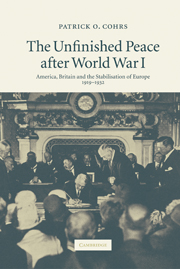Book contents
- Frontmatter
- Contents
- Acknowledgements
- List of abbreviations
- A note on the footnotes and bibliography
- Introduction
- Prologue
- 1 The wider challenges
- 2 Wilson, Lloyd George and the quest for a ‘peace to end all wars’
- 3 The ill-founded peace of 1919
- 4 The escalation of Europe's post-Versailles crisis, 1920–1923
- Part I The Anglo-American stabilisation of Europe, 1923–1924
- 5 Towards a Progressive transformation of European politics
- 6 Towards transatlantic co-operation and a new European order
- 7 The turning-point
- 8 From antagonism to accommodation
- 9 The two paths to the London conference
- 10 The first ‘real’ peace settlement after World War I
- Part II Europe's nascent Pax Anglo-Americana, 1924–1925
- Part III The unfinished transatlantic peace order: the system of London and Locarno, 1926–1929
- Epilogue
- Conclusion
- Map: Post-World War I Europe after the peace settlement of Versailles
- Bibliography
- Index
9 - The two paths to the London conference
The Dawes process and the recasting of European international politics
Published online by Cambridge University Press: 21 July 2009
- Frontmatter
- Contents
- Acknowledgements
- List of abbreviations
- A note on the footnotes and bibliography
- Introduction
- Prologue
- 1 The wider challenges
- 2 Wilson, Lloyd George and the quest for a ‘peace to end all wars’
- 3 The ill-founded peace of 1919
- 4 The escalation of Europe's post-Versailles crisis, 1920–1923
- Part I The Anglo-American stabilisation of Europe, 1923–1924
- 5 Towards a Progressive transformation of European politics
- 6 Towards transatlantic co-operation and a new European order
- 7 The turning-point
- 8 From antagonism to accommodation
- 9 The two paths to the London conference
- 10 The first ‘real’ peace settlement after World War I
- Part II Europe's nascent Pax Anglo-Americana, 1924–1925
- Part III The unfinished transatlantic peace order: the system of London and Locarno, 1926–1929
- Epilogue
- Conclusion
- Map: Post-World War I Europe after the peace settlement of Versailles
- Bibliography
- Index
Summary
The period between the Anglo-American return to Europe in late 1923 and the opening of the London reparations conference in mid-July 1924 can be seen as the first of two fulcrum periods in the history of post-World War I international politics. The second was the pre-phase of Locarno in 1925. For this period cleared not only the path for the London proceedings. It also determined the future of Germany's relations with the west and, in a wider perspective, the shape of central Europe for the remainder of the 1920s. More importantly, the shape of the international system that by the mid-1920s underpinned Europe's ‘relative stabilisation’ became manifest. Or did the developments of 1924 rather have a different significance? Did they rather, as has been argued, initiate the erosion of Europe's postwar order, ultimately preparing the ground for World War II?
A comparison of what impact American and British policies had in 1924 sheds light on the complex process of intergovernmental and inter-elite accommodation that not merely ended the Ruhr crisis. In fact, two processes of change have to be examined to gauge how the path to London was cleared. Both were indeed mutually reinforcing. The first, economically orientated ‘expert process’, spurred by the United States, overcame the previous deadlock of European diplomacy. It thus spurred a second, political accommodation process, fostered by MacDonald's mediation vis-à-vis France and flanked by financial elites. It would take centre-stage after the publication of the Dawes report in early April.
- Type
- Chapter
- Information
- The Unfinished Peace after World War IAmerica, Britain and the Stabilisation of Europe, 1919–1932, pp. 129 - 153Publisher: Cambridge University PressPrint publication year: 2006



